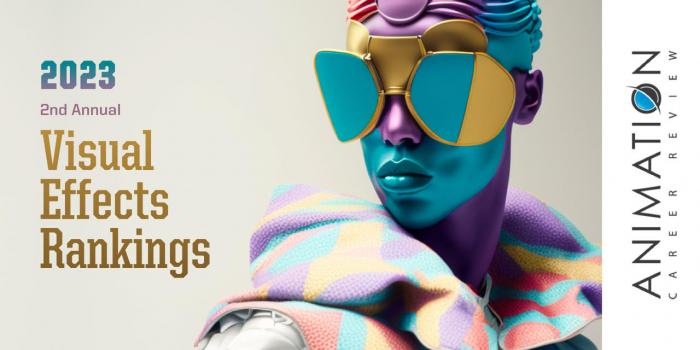

What are the top visual effects schools in the South for 2023?
| Ranking | School | State |
|---|---|---|
| 1 | Savannah College of Art and Design | Georgia |
| 2 | The Digital Animation & Visual Effects School | Florida |
| 3 | University of Central Florida | Florida |
| 4 | Florida State University | Florida |
| 5 | Georgia Institute of Technology | Georgia |
Our 2023 rankings of the Top 5 visual effect schools in the South, our second annual rankings for VFX. For an explanation of ranking criteria, click here.

The Visual Effects (VFX) Program at Savannah College of Art and Design (SCAD) has produced 86 alumni who contributed to 19 Academy Award nominated films in 2020. Examples include Star Wars: The Rise of Skywalker, Frozen 2, Avengers: Endgame, Toy Story 4, and A Beautiful Day in the Neighborhood.
SCAD VFX students have the unique opportunity to work with big brands through SCADPro—the school’s in-house design studio. Outside of SCADPro, students have opportunities create visual effects and animations with premium software such as Pixar's RenderMan, Autodesk Arnold, Nuke, Maya, Resolve, Adobe Substance 3D Painter, and Houdini. Students also have access to more than 800 networked computers and a 60,000 square-foot, state-of-the-art digital media center consisting of a green screen lab, a 75-seat in-house theater, and studio environment.
The VFX Programs at SCAD are part of the School of Animation and Motion. Three degree pathways are available including a BFA, MA and MFA. The BFA and MFA Programs are available at the Atlanta and Savannah campuses. The MA Program is available at the Savannah campus only.
At all degree levels, SCAD VFX students receive instruction from award-winning professors who have worked at major studios and on award-winning productions such as The Lion King, Pocahontas, and Ice Age. Course examples for the BFA Program include Storyboarding Essentials, Digital Visual Effects, Visual Effects Studio I-II, Concept Development for Visual Effects, Visual Effects-based Cinematography, and Professional Development for Visual Effects. VFX BFA students have the option to complete an internship, 500-level SCADpro Elective, or a Business-focused Elective.
MA Students will take courses such as Programming Concepts for Visual Effects, Modeling for Visual Effects, Visual Effects Theory and Application, Visual Effects MA Studio and Visual Effects Portfolio. The Graduate Internship is optional. MFA students will take courses such as Visual Effects Studio I: Preproduction, Visual Effects Studio II: Production, Particles and Procedural Effects: Stochastic and Calculated Methodologies, Visual Effects Theory and Application, and Digital Compositing II: Advanced Studies of Multi-layered Integration. The Graduate Internship is required as well as successful completion of the Visual Effects MFA Thesis.
Graduates of the VFX Programs at Savannah College of Art and Design hold positions such as Visual Effects Artists, CGI FX CGI Technical Directors, 3D Environment Artists, Lighting Technical Directors, VFX Producers, Previsualization Artist, Digital Compositors, and Look Development Artists at major studios around the world. SCAD graduates work at Blizzard Entertainment, Disney, Pixar, DreamWorks Animation, Shade VFX, Pixomondo, and Blur Studio.
Providing more than 100 degree program options and over 75 minors and certificate programs, Savannah College of Art and Design (SCAD) has more programs and specializations than any other art and design college in the U.S. Founded in 1978, the school opened in 1979 with just 71 students, one classroom, and an administration building. Today, SCAD serves more than 15,000 students across campuses in Atlanta and Savannah, Georgia, and Lacoste, France. Savannah College of Art and Design is accredited by the Southern Association of Colleges and Schools Commission on Colleges (SACSCOC).

The Digital Animation & Visual Effects School (DAVE School) has a Visual Effects Production (VFX) Program with two option including a 12 month Diploma consisting of 60 credits and the 32 month Bachelor’s degree consisting of 120 credits. Students in both programs will master industry software such as Maya, Unreal Engine, and After Effects, while working their way through the production process from start to finish.
Both program options are taught in a flexible, hybrid format that combines live, online classes with studio residencies held at the Orlando, Florida campus. Courses for the program are project-based, and include titles such as Dynamics and Visual Effects for Motion Graphics, VFX & Compositing, Emerging VFX Tech & Pipelines, Digital Compositing, Character, Prop and Environment Modeling, Rotoscoping, 3D Animation for Motion Graphics, and Level Design. DAVE School students will also learn the basics of creating a start-up.
Students in all DAVE School programs will build a demo reel and create a portfolio. Graduates work at major studios around the world. Some DAVE School alumni go on to launch their own studios or freelance businesses.
The Digital Animation & Visual Effects (DAVE) School was founded in 2000. Located on the backlot of Universal Studios, Florida, The DAVE School is an academic unit of NUC University, which is accredited by the Middle States Commission on Higher Education (MCSHE). DAVE serves around 1,000 students enrolled in six programs leading to a Bachelor’s degree or Diploma.

The College of Arts and Humanities at University of Central Florida (UCF) houses the School of Visual Arts & Design (SVAD). Within the School is a specialized graduate program for students seeking employment at studios and artists looking to make their own independent films. This three-year, 60 credit hour Program leads to an Emerging Media MFA with an Animation & Visual Effects Track.
Program features include labs and studios equipped with the same industry-standard software used in professional studios around the world; courses and projects led by professors with experience and connections in the industry; and the opportunity to co-direct a team of Emerging Media: Character Animation (BFA) students.
Course examples for the SVAD UCF Emerging Media MFA Program include Visual Effects for Animation and Live Action, Directing for Animation and Visual Effects, Script and Story Development for Animation and Visual Effects, Animation and Visual Effects Production I-IV, Visual Development for Animation and Visual Effects, Editing for Animation and Visual Effects, Technical Problem Solving for Animation and Visual Effects, Media and Music for Animation and Visual Effects, The History of Animation and Visual Effects, and Guerilla Marketing and Models of Distribution.
The Emerging Media MFA Program culminates with the 12 credit hour Visual Effects or Animation Thesis. This final film project allows students to display their visual storytelling skills while using VFX and Animation techniques such as stop-motion, 3D computer animation, and more.
Graduates of the Emerging Media MFA Program at University of Central Florida have been hired by a variety of organizations and studios such as Nickelodeon Animation, Blur Studio, Epic Games, Electronic Arts (EA), Pixar, Riot Games, Blizzard Entertainment, Walt Disney Animation Studios, NASA, Weta FX, Framestore, Lightbox, Titmouse, Lockheed Martin, Netflix, DiSTI, Reel FX, and the U.S. Navy.
University of Central Florida opened in 1968 as Florida Technological University. On the first day of classes, the school had less than 2,000 students. Today, UCF serves around 70,400 students, making it the largest university by enrollment in the state of Florida, and one of the nation’s largest universities. The school provides 240 bachelor’s degrees, 214 master’s degrees, and 81 doctorate degrees across 13 colleges. University of Central Florida is accredited by the Southern Association of Colleges and Schools Commission on Colleges (SACSCOC).

The College of Motion Picture Arts at Florida State University (FSU) has several programs that can prepare students for careers in visual effects (VFX). Options include a limited-access Motion Picture Arts BFA Program with Concentrations in Production and Animation and Digital Arts, and an MFA in Production. Students in all programs can pursue a variety of specialization areas through more than 30 electives. Examples of Specialization areas include Visual Effects, Screenwriting, Documentary Filmmaking, and Film Business.
Available VFX-related course examples across programs include Visual Effects Cinematography, History and Practice of Visual Effects and Animation, Visual Effects Aesthetics, Compositing I-II, Motion Picture Sound, 3D Computer Animation, Lighting, Texturing, and Rendering, Digital Studio Department Leadership, Motion Picture Editing, 3D Computer Graphics, Production Design Workshop, Filmmaking, Stop-Motion Animation, and Advanced Workshop in Area of Specialization.
Additional program features include small class sizes of no more than 15 students; the opportunity to complete several major films, including the thesis film; and the option to complete a professional internship in a studio environment. All FSU College of Motion Picture students may participate in the Torchlight Program, which provides instruction in the marketing, finance, and distribution of films.
Graduates of the Motion Picture Arts Program at Florida State University are prepared to pursue positions in the Entertainment Industry. Potential job titles include Visual Effects Artist, Effects Animator, CG Lighter, Rigger, Animator, Animation Supervisor, Modeler, Animatics Supervisor, and Storyboard Artist.
Founded in 1851, Florida State University serves approximately 45,495 students enrolled in more than 275 degree programs at all levels. One of the largest and the oldest continuous site of higher education in Florida, FSU houses 16 colleges and schools at campuses across the state. Florida State University is accredited by the Southern Association of Colleges and Schools, Commission on Colleges (SACSCOC).

Georgia Institute of Technology (Georgia Tech) has been offering Digital Video Special Effects Production and Computer Animation courses since 1999. Today, the school has several paths to study Visual Effects (VFX) and Special Effects.
Georgia Tech’s Ivan Allen College of Liberal Arts houses the School of Literature, Media, and Communication (LMC). Georgia Tech is also home to the College of Computing. Together, these colleges and schools house the Computational Media (CM) BS (BSCM) Program, MS and PhD degrees in Digital Media, and a 19 credit hour Computing & Media Minor.
The Computational Media Program at Georgia Tech’s launched in 2004 with just one student. Today, the Program serves more than 300 students, making it one of Georgia Tech’s fastest growing programs. Across programs, available course and topics include Digital Video Special Effects, Special Effects, Experimental Media, Interaction Design, Computer animation, Constructing the Moving Image, Computer Graphics, Objects and Design, Reality Experience Design, and Special Topics in Digital Media.
Degree-seeking students at Georgia Tech have the option to add a Film Studies Minor (offered in the School of LMC), which allows them to take production courses, such as VFX, as part of elective requirements. Examples include Video Production, Experimental Film, Advanced Video Production, Film and/as Technology, and Cinema and Digital Culture.
Georgia Tech School of LMC students have access to post-production labs outfitted with Adobe Creative Cloud Suite and DaVinci Resolve software. The School of LMC is also home to LMCFilms—a film and video equipment rental house that provides a range of industry-standard equipment for students and researchers working in the entertainment industry.
Graduates of the CM, Digital Media, and Computing & Media Programs at Georgia Institute of Technology work in Visual and Special Effects, Film Production, Animation, Interactive Design, 3D Modeling, and Game Simulation.
Georgia Institute of Technology was established in 1885. When it opened, the school had just 129 students enrolled in one degree program—the Mechanical Engineering BS. Today, Georgia Tech serves more than 40,000 students enrolled in more than 180 degree programs and minors across six distinct colleges and 28 schools. Georgia Institute of Technology is accredited by the Southern Association of Colleges and Schools Commission on Colleges (SACSCOC).
